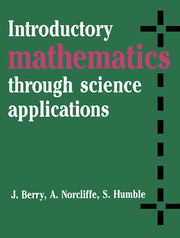Book contents
- Frontmatter
- Contents
- Preface
- 1 Basic functions
- 2 Functions for science 1: the exponential function
- 3 Functions for science 2: trigonometric functions
- 4 Functions for science 3: inverse functions
- 5 Other functions of science
- 6 Differentiation 1: rates of change
- 7 Differentiation 2: stationary points
- 8 Differentiation 3: approximation of functions
- 9 Integration 1: introduction and standard forms
- 10 Integration 2: techniques of integration
- 11 Integration 3: further techniques
- 12 First-order ordinary differential equations
- 13 Second-order ordinary differential equations
- 14 Statistics 1: frequency distributions and associated measures
- 15 Statistics 2: probability and probability distributions
- 16 Statistics 3: sampling, sampling distributions and hypothesis testing
- 17 Partial differentiation 1: introduction
- 18 Partial differentiation 2: stationary points
- Answers to the exercises
- Index
17 - Partial differentiation 1: introduction
Published online by Cambridge University Press: 05 June 2012
- Frontmatter
- Contents
- Preface
- 1 Basic functions
- 2 Functions for science 1: the exponential function
- 3 Functions for science 2: trigonometric functions
- 4 Functions for science 3: inverse functions
- 5 Other functions of science
- 6 Differentiation 1: rates of change
- 7 Differentiation 2: stationary points
- 8 Differentiation 3: approximation of functions
- 9 Integration 1: introduction and standard forms
- 10 Integration 2: techniques of integration
- 11 Integration 3: further techniques
- 12 First-order ordinary differential equations
- 13 Second-order ordinary differential equations
- 14 Statistics 1: frequency distributions and associated measures
- 15 Statistics 2: probability and probability distributions
- 16 Statistics 3: sampling, sampling distributions and hypothesis testing
- 17 Partial differentiation 1: introduction
- 18 Partial differentiation 2: stationary points
- Answers to the exercises
- Index
Summary
Scientific context
In earlier chapters we made a study of many of the functions commonly used in science and we showed how to obtain their derivatives. The functions we have considered so far have been functions of a single variable. In science there are many situations where some quantity of interest is related to not just a single variable but to several. In such situations these relationships would be modelled mathematically by functions of several variables.
In order to understand the properties of functions of one variable, we needed to differentiate and sketch out the graph of the functions. Similarly, we need to carry out the same operations in the several variable case. To differentiate functions of several variables involves knowing how to work out what are called partial derivatives and obtaining partial derivatives is the central theme of this first chapter on partial differentiation.
As we shall see, the partial derivative of a function of several variables is a straightforward extension of ordinary differentiation just as functions of several variables are a straight forward extension of the single variable case.
Example 1: van der Waal's equation of state. Pure substances can exist in various phases, namely gas, liquid and solid, and whether the phase is a gas, a liquid or a solid is determined essentially by the values of pressure, volume and temperature of the substance.
- Type
- Chapter
- Information
- Introductory Mathematics through Science Applications , pp. 466 - 497Publisher: Cambridge University PressPrint publication year: 1989



